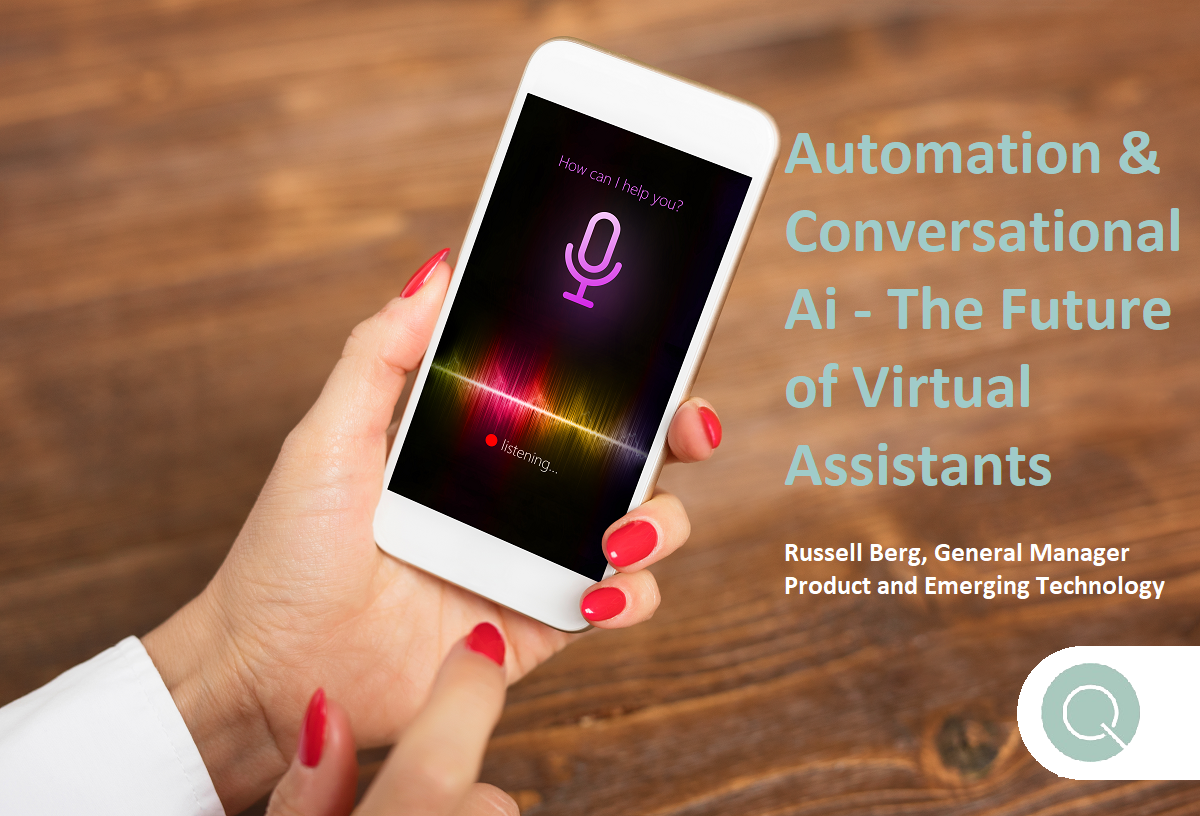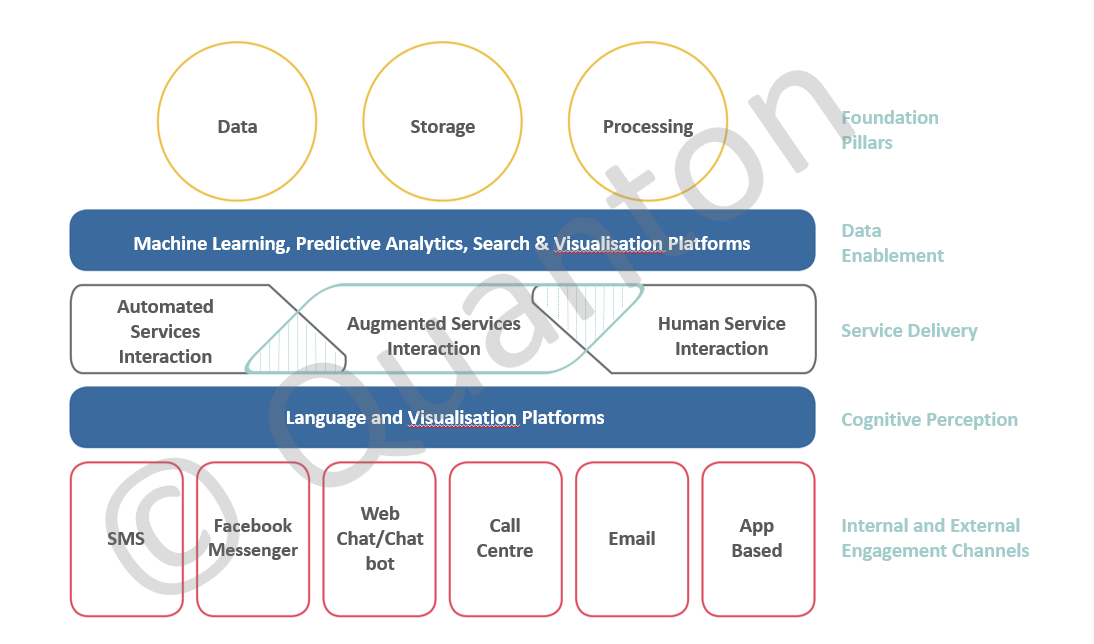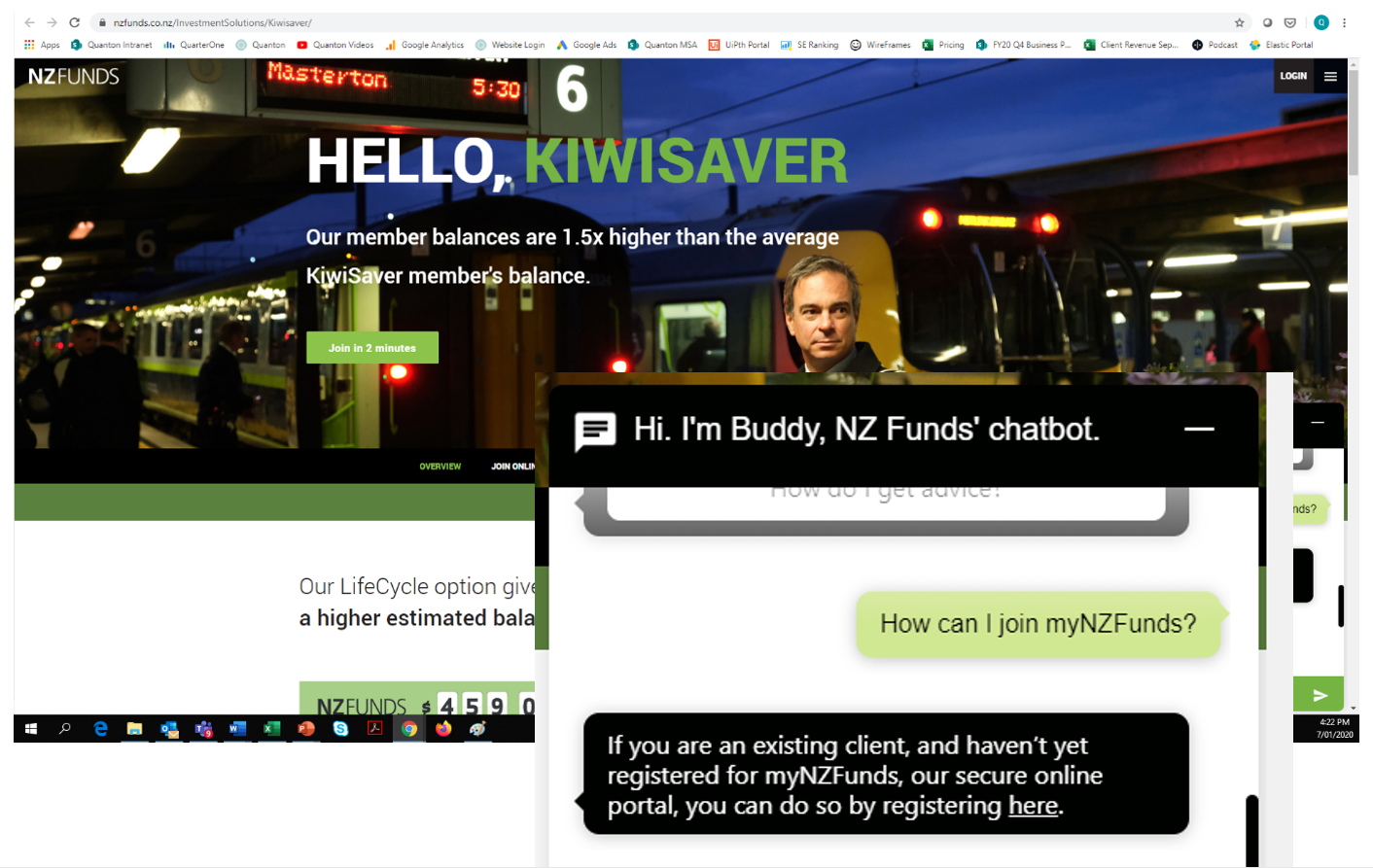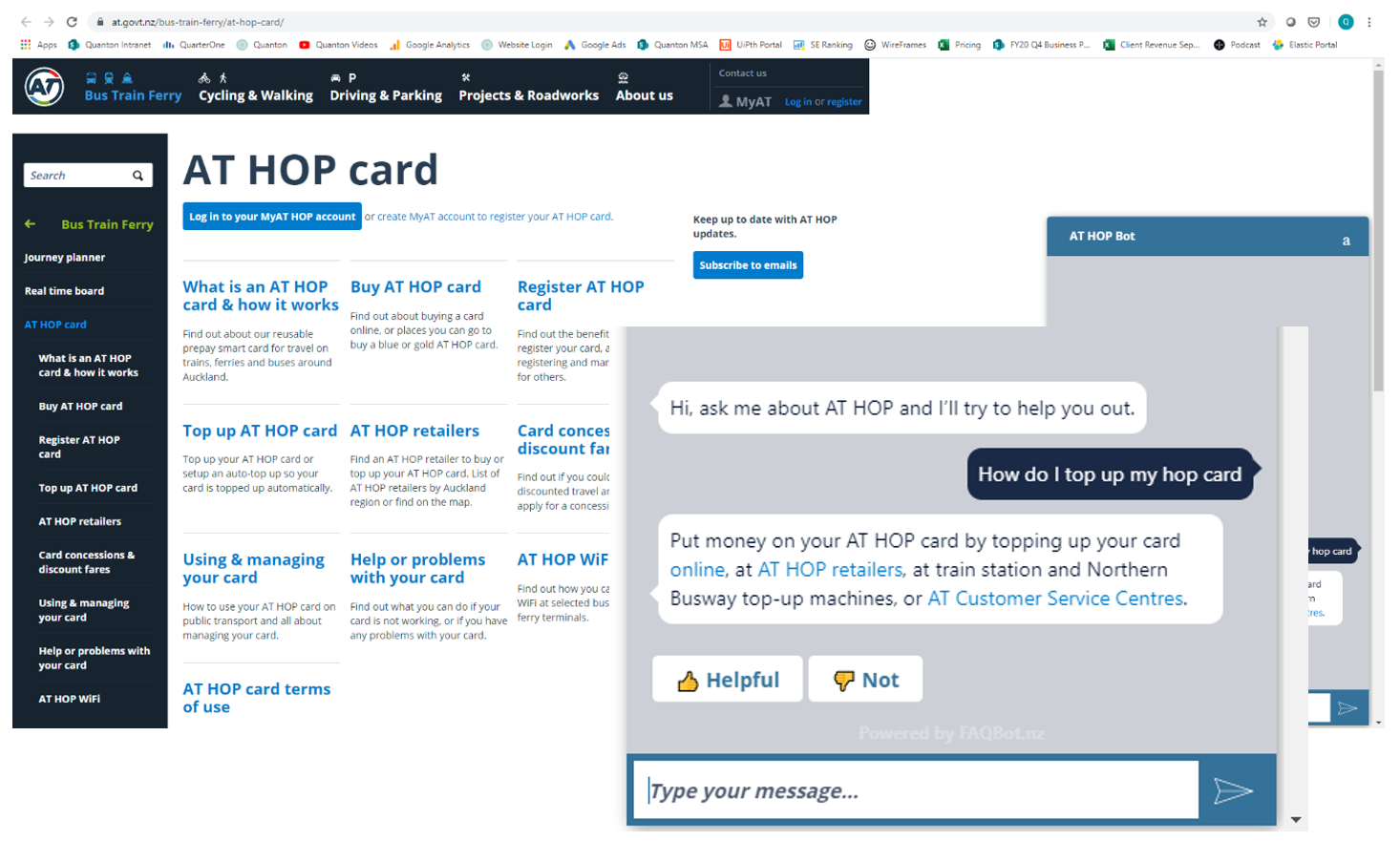
Conversational AI is a growth area, offering new ears and a mouth for virtual assistants. Add in new arms and legs with automation and Kiwi businesses could reap big returns.
The Quanton team has built a working proof of concept for a conversational AI capability that integrates with a chatbot interface and a Robotic Process Automation solution.
In early January our delivery team took advantage of the rare opportunity to embark on a New Year challenge, before client engagements restarted following the Christmas break. The team rose to the occasion and the results were exciting.
Based on the combination of Natural Language Processing (NLP) including intent analysis and response, a chatbot interface and Robotic Process Automation (RPA), the team created a conversational AI proof of concept capable of interacting with customers through voice or text, interpreting a request and completing tasks.
Underpinned by Google cloud services and Blue Prism (we chose Blue Prism for the project but could have achieved the same outcome with UiPath) the proof of concept created is channel agnostic meaning it can be integrated to voice channels like a call center Interactive Voice Response (IVR) or text channels like a chatbot, website messenger, Facebook Messenger or Slack.
Figure One: Conversational Ai Platform with Robotic Process Automation and Chatbot interface.

The use case the team chose was ordering office groceries online. If you’re thinking this is a simple or unexciting use case, please remember we gave our team just five working days from the moment go to pull this off. This is where Robotic Process Automation comes in.
The conversational AI platform was used to determine the intent of the customer and collect required information, such as which items were wanted and in what quantity, before calling Blue Prism, a RPA platform, to initiate the process and serve the required data. The RPA solution then executes the task by accessing target systems, in this case a website, and provides an outcome response back to the customer.
Three global conversational ai and automation trends
Trend one: The rapid growth of automation in customer service interactions
In 2019 Gartner predicted that 25% of customer service and support operations will integrate virtual customer assistant technology across engagement channels by 2020 (yes that's this year), up from 2% in 2017.
Business growth and service delivery and quality are intrinsically linked to headcount and human capability. The powerful combination of conversational AI and automation is another tool to de-couple the historic dependency of headcount in relation to business growth and scalability, as well as other operational imperatives like cost control, quality and compliance.
“Conversational platforms will drive a paradigm shift in which the burden of translating intent shifts from agent to computer.”
- Gartner
Technology also exponentially increases the possibilities of service delivery by removing the constraints and barriers of previous support and customer service models. Customer service, or elements thereof could have the ability to be on 24 hours a day, 7 days a week, 365 days a year.
Equally businesses would become less constrained by where they make customer service available. Whether it’s on Facebook messenger, a mobile app or by text message - It’s time to flip the model and be where the customer wants the business to be and not where it’s most effective of cost-efficient for the business to drive the customer.
Trend two: The shift away from conversational solutions to conversational platforms and capability
Conversational AI normally refers to the use of speech technologies like NLP, sentiment analysis and speech to text or text to speech, to automate communication and create personalised experiences in messaging apps, speech-based assistants and chatbots – at scale.
The concept is not new. Businesses have been using IVR’s for decades and chatbots have been a clear trend in local and global market. However, conversational technology has tended to be directly linked to the solution it is contained within.
While this approach is valid, the clear shift in the market is a movement towards creating conversational platforms which are channel agnostic. For example, the ability to integrate the platform with text and voice channels alike such as Facebook Messenger, a chatbot, your website, SMS or IVRs versus single solutions such as a chatbot.
Designed, implemented and managed correctly conversational AI platforms have the potential to be a strategic asset for businesses. Powered by AI, as a single source of truth for conversational customer experiences the numerous positive impacts can include broad cost reductions and customer experience improvements.
Trend three: The desire to link automation and conversational capability
Deployed in isolation, conversational technologies like chatbots can be limited in the value they can deliver.
One way they could be viewed is highly advanced search engines. I do acknowledge exceptions to this general statement with examples of Chatbots that have clearly been highly integrated with well-designed customer experiences.
Below are two examples. In each scenario I asked to do something relevant to the website I was on. In each case the result was the chatbot directing me to a targeted page on the website. Helpful? Somewhat.
In effect a chatbot, or any other automated conversational channel could be viewed as the mouth and ears – the ability to receive and send communications to humans.
What would happen if we gave arms and hands to this capability?
By using automation to provide the ability to action tasks based on the request made and information received, that's exactly what we're doing. And it's an emerging trend that is not lost to the minds of leading brands around the world.
Take for example, a banking scenario, where you ask a chatbot about credit cards. Based on the current capability of chatbots you would likely be directed to the credit card page of a website. But if we extended this capability with automation, the outcome could be the chatbot asking some questions to recommend the best option (notwithstanding the complexities around Robo Advice and the Financial Advisers Act 2008) and then obtain the required application information to serve into an automation solution for processing.
Based on the required business rules applications could be processed and approved using automation offering a full end-to-end solution with any exceptions referred to a human customer service agent.
Banking isn't the only potential benefactor. I’ve seen a proof of concept by one of our technology partners which verified customer identification using randomly selected security questions. I’ve also seen demonstrations where the technologies made or updated service bookings, responded to customer account enquiries like balances and recent payments, or completed customer requests like sending copies of an invoice all using voice or text inputs.
The concept of extending customer service conversations using automation is also highly relevant to businesses who are already employing conversational AI in targeted solutions like IVR technology or chatbots. Simply integrating automation capability with these technologies can have a positive impact extending existing benefit already being achieved.
What is the full potential for automation and conversational ai platforms?
The emergence of conversational AI it’s application in conjunction with automation is being widely adopted globally and is one of the key trends that was very evident at the 2019 San Francisco Ai Summit where multiple presenters shared case study results.
One of my favourite client presentations was by Comcast, a US based cable television provider which on on a daily basis have a staggering 25 million utterances by NLP, delivers 70,000 predictive recommendations through IVR, mobile apps, web and social, and achieved a 10-40% improvement to NPS scores per interaction.
The key piece of this example which I want to focus on is the delivery of predictive recommendations. Using a machine learning backbone and automation capability Comcast is identifying problems before they occur and pro-actively reaching out to their clients. That is the nirvana of gold standard customer service.
Finally MetLife USA, with over 90 million customers, is amongst the largest global providers of insurance, annuities and employee benefit programmes. It achieved a reduction in average call handing time of 45 seconds, improved customer satisfaction by 7% and now handle over 25% of all customer calls without any agent involvement through the use of conversational AI.
Relative to existing operating models I see very few use cases where conversational AI and automation couldn’t be applied.
How do conversational AI platforms integrate into New Zealand businesses?
New Zealand business need to adopt future-ready business models to remain relevant and sustainable.
Automation capability and a conversational AI platform is not necessarily one technology.
I typically radiate towards multi-technology solutions to provide the greatest level of scalability, flexibility and durability, relative to the existing architecture and technology mix of a business.
More importantly my view is that automation and conversational AI capability are one part of an ‘AI operating model’.
Conversational AI can be implemented independently but I am an advocate for it to be implemented as part of a wider road-map and digital transformation strategy that includes Machine Learning, automation, vision technologies and data analytics and visualisation.
Figure Two: Ai Operating Model

So what's it all mean for NZ business?
Like many things in life, talking about where to start is often easier said than done. How will also depend on the orientation of your business.
The answer to where to start is always start small and think big. Understand the level of opportunity, focus on pain points and solve problems and focus on in-line processing for existing processes. Most importantly identify areas that offer short-term value to the business, while laying a path for longer-term transformation. This is not a suggestion to be tactical versus strategic, but a recommendation to ensure you show early value and return on investment.
Here in New Zealand, we're in active conversation with customers who want to understand how they can integrate conversational AI and automation into their operating models.
While it’s not a solution for every use case - if you’re only getting asked once a month to do something there likely isn’t a use case - but for areas of core requests in businesses conversational AI and automation will have a role to play going forward. Both for external facing customer service assistant and for internal facing virtual assistants.
In fact, there are very few use cases that conversational AI and automation couldn’t be used to address.

A quote I regularly reference from Steve Guggenheimer from Microsoft seems apt to conclude with.
“It’s too early to do everything, but it’s too late to do nothing.”



